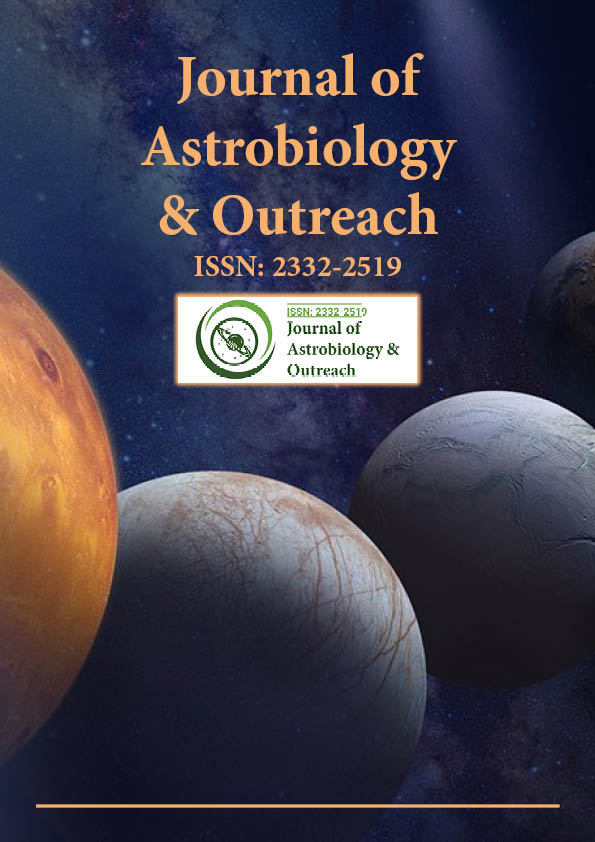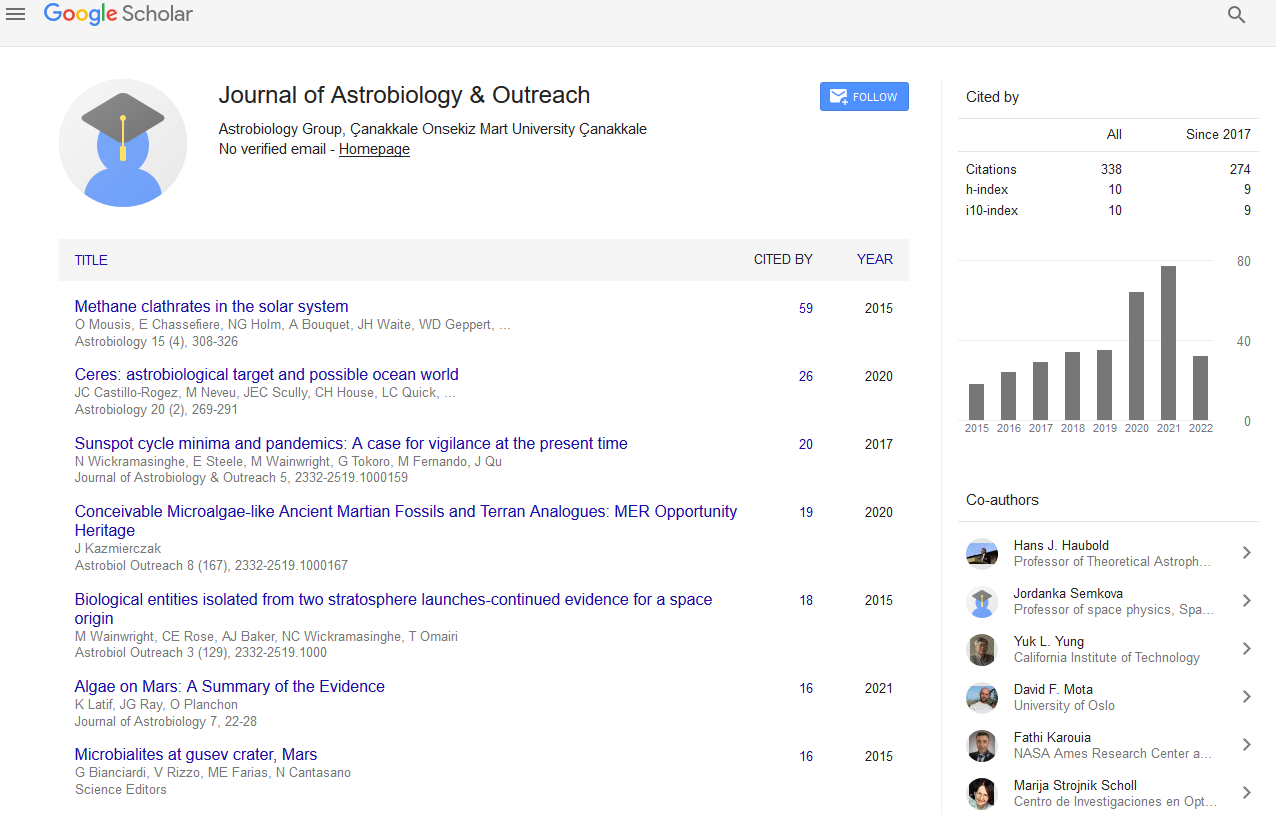Indexed In
- Open J Gate
- Academic Keys
- JournalTOCs
- RefSeek
- Hamdard University
- EBSCO A-Z
- OCLC- WorldCat
- Google Scholar
Useful Links
Share This Page
Journal Flyer

Open Access Journals
- Agri and Aquaculture
- Biochemistry
- Bioinformatics & Systems Biology
- Business & Management
- Chemistry
- Clinical Sciences
- Engineering
- Food & Nutrition
- General Science
- Genetics & Molecular Biology
- Immunology & Microbiology
- Medical Sciences
- Neuroscience & Psychology
- Nursing & Health Care
- Pharmaceutical Sciences
Opinion Article - (2024) Volume 12, Issue 4
Advancing Sky Map Computation in Gamma-Ray Astronomy through Adaptive Kernel Density Estimation
Claire Lefevre*Received: 29-Nov-2024, Manuscript No. JAO-24-28019; Editor assigned: 02-Dec-2024, Pre QC No. JAO-24-28019 (PQ); Reviewed: 16-Dec-2024, QC No. JAO-24-28019; Revised: 23-Dec-2024, Manuscript No. JAO-24-28019 (R); Published: 30-Dec-2024, DOI: 10.35248/2332-2519.24.12.369
Description
The field of gamma-ray astronomy continues to expand the boundaries of our understanding of the high-energy universe, providing insights into phenomena such as stellar explosions, gamma-ray bursts and black hole activity. The foundation of these investigations lays the ability to produce accurate sky maps that depict gamma-ray source distributions. Traditional techniques often struggle to balance resolution and sensitivity, which can lead to either an underrepresentation of faint sources or an overemphasis on noise. Adaptive Kernel Density Estimation (KDE) emerges as a potential solution, providing flexible adjustments to resolution based on local data density. This article explains the transformative potential of adaptive KDE in gamma-ray astronomy and its consequences for sky map computation.
Sky maps in gamma-ray astronomy are fundamentally statistical reconstructions. They depend on the positional data of detected photons, typically recorded by telescopes such as Fermi-LAT or HESS. Conventional methods often use fixed bandwidth KDE, where a single smoothing parameter applies across the entire map. While computationally straightforward, fixed bandwidth approaches can introduce significant limitations. In regions with high photon density, such as areas near bright sources, a broad kernel may blur important features, reducing spatial resolution. Alternatively, in low-density regions, a narrow kernel may reduce statistical noise, leading to false detections.
Adaptive KDE, by contrast, provides the flexibility to customize the bandwidth to local photon density. This method involves adjusting the smoothing parameter to account for variations in data density. In regions of high photon density, such as the surroundings of a strong gamma-ray source, the bandwidth is reduced, preserving finer spatial details. In low-density regions, where photon counts are sparse, the bandwidth increases, effectively suppressing noise. This adaptive approach not only improves the accuracy of the resulting sky map but also provides a more accurate representation of the true fundamental source distribution.
One of the most important advantages of adaptive KDE in gamma-ray astronomy is its capacity to improve source localization. Precise localization is critical for correlating gammaray sources with astrophysical counterparts observed in other wavelengths, such as X-rays or radio waves. By minimizing oversmoothing near bright sources and noise amplification in sparse regions, adaptive KDE produces sharper, more reliable sky maps. This advancement is particularly important for identifying transient events, such as gamma-ray bursts, where accurate and rapid localization can guide follow-up observations across the electromagnetic spectrum.
The implementation of adaptive KDE, however, is not without challenges. One of the primary concerns is computational complexity. Continuously adjusting the kernel bandwidth for each data point or pixel requires significantly more processing power than fixed bandwidth approaches. Efficient algorithms and parallel computing strategies are essential to make adaptive KDE practical for large datasets, such as those produced by modern gamma-ray observatories. Despite these computational demands, the benefits of improved source detection and localization make adaptive KDE a worthwhile investment.
The adoption of adaptive KDE also raises questions about parameter selection and optimization. Determining the criteria for bandwidth adjustment requires careful consideration, as overly aggressive smoothing can erase genuine features, while insufficient smoothing may fail to suppress noise. Future studies must focus on developing standardized approaches for parameter tuning, ensuring that adaptive KDE techniques are reproducible and applicable across different datasets and observational conditions.
From a broader perspective, the use of adaptive KDE in gammaray astronomy aligns with the growing trend of incorporating machine learning and advanced statistical methods into astrophysical research. By utilizing adaptive techniques, astronomers can extract more information from existing datasets and prepare for the influx of data from next-generation observatories. Instruments such as the Cherenkov Telescope Array (CTA) and the proposed AMEGO-X mission will generate unprecedented volumes of gamma-ray data, necessitating sophisticated analysis methods to fully realize their scientific potential.
In conclusion, adaptive KDE represents a significant step forward in sky map computation for gamma-ray astronomy. Its ability to continuously balance resolution and sensitivity addresses challenges in source localization, background modeling and faint source detection. As the field continues to evolve, the combination of adaptive KDE into standard analysis pipelines holds the potential to improve our understanding of the gamma-ray universe, revealing new astrophysical phenomena and refining our models of cosmic high-energy processes. While challenges related to computation and parameter selection remain, ongoing advancements in algorithms and computational power.
Citation: Lefevre C (2024). Advancing Sky Map Computation in Gamma-Ray Astronomy through Adaptive Kernel Density Estimation. J Astrobiol Outreach. 12:369.
Copyright: © 2024 Lefevre C. This is an open-access article distributed under the terms of the Creative Commons Attribution License, which permits unrestricted use, distribution, and reproduction in any medium, provided the original author and source are credited.

